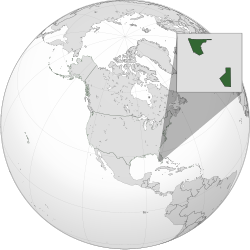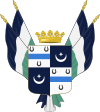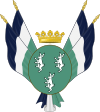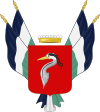Empire of Garránia
This article refers to a micronation or element of micronationalism which is defunct and no longer exists. You can help make the article reflect that or ask on the talk page for further information. |
Empire of Garránia | |
|---|---|
| Motto: "Beo fada agus soirbhigh" "Live Long and Prosper" | |
| Anthem: "Venus, the Bringer of Peace" | |
| National Waltz: "Merry Go Round of Life" | |
 Location of the central territories of the Empire of Garránia within the United States | |
| Status | Defunct |
| Capital and largest city | Ensorburgh |
| Official languages | English, Irish |
| Recognised national languages | Spanish, Arabic |
| Recognised regional languages | Romanian, Smith Island dialect |
| Religion (2022) | None |
| Government | Anocratic monarchy |
• Emperor | Ezekiel Ensor |
| Legislature | Grand Council |
| Independence from the United States | |
• Independence declared | 1 July 2022 |
• Became Sawdu Protectorate | 19 January 2024 |
• Dissolved | 21 May 2024 |
| Area | |
• Total | 4.78 km2 (1.85 sq mi) |
• Water (%) | %3.29 |
| Population | |
• 2023 estimate | 3,300 |
• Density | 696/km2 (1,802.6/sq mi) |
| Membership | 12 |
| HDI (2023) | 0.86 very high |
| Currency | Garránian Pounds |
| Time zone | UTC-5 (EST) |
• Summer (DST) | UTC-4 (EDT) |
| Antipodes | Indian Ocean |
| Date format | dd-mm-yyyy (CE) |
| Driving side | right |
| Calling code | +1 |
| IMSO 1 code | GAR |
| Part of a series on |
| Garránia |
|---|
 |
| General |
| Constituent States |
| Government Organizations |
| Online Allies |
Garránia (US: /ɡərɑːniə/ (![]() listen)), officially the Empire of Garránia, is an unrecognized sovereign state. Most of its territory is located in the U.S. state of Florida. Ensorburgh is the de facto capital city and current seat of the Emperor.
listen)), officially the Empire of Garránia, is an unrecognized sovereign state. Most of its territory is located in the U.S. state of Florida. Ensorburgh is the de facto capital city and current seat of the Emperor.
Since the establishment of Garránia in mid-2022, it has been an imperial anocratic federal monarchy, and is one of the only ones in modern micronationalism. Garránia declared independence from the United States originally on June 21, 2021 as the Serene Canton of Radnia, and since then it has gone through many changes.
History
Pre-Garránian History
For thousands of years starting around 10,000 BCE, the area which is today Garránia was inhabited by Native American tribes, the most recent of which being the Calusa subculture, the Caloosahatchee. The decline of their civilisation began in 1513, upon first contact with the Spanish conquistador Juan Ponce de León. As the Spanish colonised the area, they used alliances with other tribes and their own military power to wage open war against the Calusa. Eventually, the dwindling Calusa culture moved into the Everglades, integrating over time into the Seminole tribes. Starting in the late 1810s, General Andrew Jackson began invading the Spanish Florida territory, as part of the Seminole Wars. It was in these wars that the United States took Florida from the Spanish, and where the settlement of Ft Myers was originally founded. During the Civil War, the fort briefly served the Confederate States, but was taken and held by the Union Army from 1864 to the end of the war. It has since become a major settlement in the area, and a decently sized city within the state of Florida.
Micronational History
Pre-Micronational Era
Ensor moved to Fort Myers from Westminster, Maryland in November 2018. Several fictional nations were drafted, unrelated to micronationalism, as Ensor had an interest in worldbuilding and a budding interest in geopolitics. After being introduced to micronationalism by a now infamous video by the Youtube channel "Not Exactly Normal," Ensor began to come up with ideas for a micronation, originally wanting to adapt one of the fictional nations from the past. However, they changed their mind and instead chose to create an original micronation.
Era of Young Micronationalism
Radnian Era
On 21 June 2021, Ensor founded the Serene Canton of Radnia. An originally isolationist state, it was founded on centrist ideals and Taoist philosophy. It was not very serious, as it was Ensor's first experience with micronationalism. It was inspired primarily by micronations such as the Democratic Republic of Benjastan and the Republic of Molossia. Many early connections were made, operating as young micronationalists often do, forming pointless intermicronational organizations and signing shallow alliance treaties. Some of these early connections were formed through the foundation of the Euro-American Micronational Alliance and its successor, RANE.
Starting from 16 January 2022, a major restructuring to Radnia had gone underway, taking a more serious and realistic approach to micronationalism, seeing the more serious side of the community. At the suggestion of others, Radnia had made a cultural shift, leaning heavily into Chinese cultural motifs.

Fuchsia Era
This era began on 10 February 2022 following the transition from Radnia to Shulinguo. After the transition was made, Shulinguo made an attempt at democratizing. This was largely in vain, no progress was ever made and Ensor eventually lost patience.
Shulin Era
On 26 April 2022, the Shulin Empire was established. Ezekiel Ensor was pronounced Emperor. After involvement in several foreign civil disputes including the Zepranan Civil Conflict, the Emperor decided to bring their attention back to Shulin. On June 30, the Emperor put into motion a "closing period" to finish projects before dormancy was to be declared while the Emperor developed Garránia.
Establishment of Garránia
On 1 July 2022, Garránia was established to replace the Shulin Empire. Over the next weeks, a stable system was established, based off of the Norwegian, Swedish, and British Monarchies, as well as the Republic of Ireland. On about 17 August 2022, Ensor made the decision to leave the online community. "The online micronational community is no longer a place to exercise a fun hobby and share it with others, but now a cesspool of racist teenagers with behavioral issues to be bigoted against anybody without consequence." They began to transition to a more physical, traditional form of micronationalism and micronational diplomacy.
Isolationist Era
Garránia adopted a new policy of only establishing diplomacy with nations that they could feasibly conduct physical diplomacy with. The Emperor also removed many members of the Parliament which they did not know personally, preparing to reform parliament when enough people got involved in person. Online involvement was resumed, but only as a forum for discussion and not for diplomacy. Slowly, over time, the isolationist policy relaxed and though they remained mostly isolationist, a newer, more mature approach to micronationalism was assumed and though they did not sign treaties with just anybody, as had been done in the Radnian and Shulingese Eras, they engaged in online conversation and light diplomacy. The government began to greatly expand, with more becoming interested in joining the government Ensor knew personally.
Golden Era
This era is believed to have formally begun when Garránia joined the Cupertino Alliance as a provisional member on 1 March 2023. A proliferating feeling of clarity and maturity washed over the nation, as it expanded into new artistic frontiers and began to establish more well-standardized systems of classification.
Government
Structure
The Empire of Garránia is a federal anocratic imperial monarchy, with an autocratic emperor and an oligarchic Grand Council appointed by the emperor. The Empire of Garránia has a complex form of government that can be described as a federal anocratic imperial monarchy. This means that power is distributed between the central government and various regional subdivisions, and that the form of government is characterized by a mix of both democratic and autocratic elements.
At the core of the Empire's power is the emperor, who possesses supreme executive authority over the state. The emperor is an autocrat, granting them unchecked power to make decisions and enforce policies without significant input or oversight from other branches of government. The emperor's authority is derived from their status as the head of state and the symbol of national unity.
However, the emperor is not the sole source of power in the Empire. The oligarchic Grand Council serves as a group of advisors and administrators who are appointed by the emperor. This council is responsible for overseeing various aspects of government, such as finance, lawmaking, and military affairs. Typically, council members are chosen from the ranks of the nobility or other influential elites, serving at the emperor's pleasure.
In addition to the autocratic and oligarchic elements of the government, the Empire is also characterized by a federal structure. This means that power is divided between the central government and various regional subdivisions, such as duchies or principalities. These subdivisions may have their own forms of government, which are overseen by local officials appointed by the emperor. While the central government retains ultimate authority, the regional subdivisions have some degree of autonomy in managing their own affairs.
Grand Council
| Members of the Grand Council (Ordered by Seniority) | ||||
|---|---|---|---|---|
| Role | Title | Member | Province | |
| Secretary of the Council | Grand Duke of Ensorburgh | |||
| Secretary of State | Duchess of Almasía | |||
| N/A | Count of Arriety | Hon. Count Maximilian Arriety | ||
| N/A | Baroness Viceroy of Caelesta | |||
| N/A | Viceroy of Micșunești | Hon. Viceroy Ștefan Marius Snagoveanu | ||
Administrative districts
| Constituent states | |||||||
|---|---|---|---|---|---|---|---|
| Flag | Coat of arms | Name | Established | Area | Official Language(s) | Leader | |
| Dominion of Florida (Upper) | |||||||

|
Grand Duchy of Ensorburgh | 1 July 2022 | 1.18 km2 | English, Irish | Grand Duke Ezekiel Ensor I, Emperor of Garránia | ||

|
Duchy of Almasía | 31 August 2022 | 0.99 km2 | Arabic, English | Duchess Shiva Sanría | ||
| Dominion of Florida (Lower) | |||||||

|
County Arriety | 3 March 2023 | 1.23 km2 | English | Count Maximilian Arriety | ||
| Protectorates / Colonies / Overseas Territories | |||||||
|---|---|---|---|---|---|---|---|
| Flag | Coat of arms | Name | Established | Area | Official Language(s) | Leader | |
| Dominion of Florida (Upper) | |||||||
| Apollo Island Protectorate | 14 April 2022 | 0.3 ha | English | N/A | |||
| Maryland Mandate | |||||||
| Protectorate of Goose Island | 26 April 2022 | 267 ha | English | N/A | |||

|
Extant Territories | ||||||

|
Viceroyality of Caelesta | 2 April 2023 | 379 m2 | Baroness Vicereine Aurora Twinkle | |||

|

|
Viceroyality of Micșunești | 10 June 2023 | 1.313 km2 | Viceroy Ștefan Marius Snagoveanu | ||
Geography
Climate & Weather
Garránia is classified as having a humid subtropical climate under the Köppen-Geiger climate classification system. This classification is given to regions with hot, humid summers and mild winters, with a year-round average temperature above 18 °C. , and frequent thunderstorms. During the winter season, temperatures are mild, ranging from 15-20 degrees Celsius, and frost and snow are rare occurrences. The spring and fall seasons are pleasant, with temperatures averaging 20-25 degrees Celsius and less humidity than summer.
However, Garránia is at risk of tropical storms and hurricanes, particularly during the Atlantic hurricane season, which runs from June 1 to November 30. The period from mid-August to late October is the most active time for tropical storms and hurricanes in the Atlantic basin. During this time, Garránia and other coastal areas of Florida are at a higher risk of experiencing severe weather conditions. Residents and visitors to Garránia are advised to take precautions during the hurricane season, such as monitoring weather forecasts, having emergency supplies on hand, and following evacuation orders when necessary.
| Climate data for Fort Myers, Florida (Page Field), 1981–2010 normals | |||||||||||||
|---|---|---|---|---|---|---|---|---|---|---|---|---|---|
| Month | Jan | Feb | Mar | Apr | May | Jun | Jul | Aug | Sep | Oct | Nov | Dec | Year |
| Record high °F (°C) | 90 (32.2) |
92 (33.3) |
93 (33.9) |
96 (35.6) |
99 (37.2) |
103 (39.4) |
101 (38.3) |
100 (37.8) |
98 (36.7) |
95 (35) |
95 (35) |
90 (32.2) |
103 (39.4) |
| Average high °F (°C) | 74.7 (23.72) |
77.2 (25.11) |
80.4 (26.89) |
84.6 (29.22) |
89.4 (31.89) |
91.5 (33.06) |
91.9 (33.28) |
91.8 (33.22) |
90.5 (32.5) |
86.7 (30.39) |
81.3 (27.39) |
76.6 (24.78) |
84.7 (29.28) |
| Average low °F (°C) | 53.7 (12.06) |
55.9 (13.28) |
59.4 (15.22) |
63.1 (17.28) |
68.7 (20.39) |
73.5 (23.06) |
74.5 (23.61) |
74.9 (23.83) |
74.3 (23.5) |
69.1 (20.61) |
62.0 (16.67) |
56.4 (13.56) |
65.5 (18.61) |
| Record low °F (°C) | 27 (-2.8) |
27 (-2.8) |
33 (0.6) |
39 (3.9) |
50 (10) |
58 (14.4) |
66 (18.9) |
65 (18.3) |
63 (17.2) |
45 (7.2) |
34 (1.1) |
24 (-4.4) |
24 (−4.4) |
| Average Rainfall inches (mm) | 1.89 (48) |
2.13 (54.1) |
2.84 (72.1) |
2.02 (51.3) |
2.72 (69.1) |
10.28 (261.1) |
9.14 (232.2) |
10.21 (259.3) |
8.55 (217.2) |
2.67 (67.8) |
1.92 (48.8) |
1.69 (42.9) |
56.06 (1,423.9) |
| Average rainy days (≥ 0.01 in) | 5.5 | 5.2 | 6.2 | 4.2 | 6.8 | 16.0 | 17.6 | 17.9 | 15.4 | 6.8 | 4.4 | 4.5 | 110.5 |
| Source: NOAA (extremes 1892–present)[1] | |||||||||||||
Hurricane Ian Disaster, September–October 2022
Hurricane Ian was a large and destructive Category 4 Atlantic hurricane, that was the deadliest hurricane to strike the state of Florida since the 1935 Labor Day hurricane. As of October 18, 118 people were confirmed dead state-wide from Ian; 61 of those deaths occurred in Lee County, and 24 occurred in neighboring Charlotte County. Garránia was left without power for 6 days, and internet services were out for 12. The Emperor Mother was put under immense stress as she worked at the time as a first responder within Ft Myers Beach, by far the hardest hit area out of those affected by the hurricane. As of October 19, the US Coast Guard is still operating in and around Garránia , and over a hundred police and fire jurisdictions from outside Lee County are present to aid the local police and fire in the cleanup and recovery effort.
Biodiversity
This section includes data for the Dominion of Florida exclusively.
Flora
Some of the most notable plant species in the Dominion of Florida include the cypress tree (Taxodium distichum), which is known for its impressive size and lifespan, reaching heights of up to 30 meters and some living for over 1,000 years. The saw palmetto (Serenoa repens), a hardy palm species that is common throughout Florida, is also prevalent in the region. This palm species can grow up to 3 meters tall and produce small berries that are used in traditional medicine for their anti-inflammatory properties.
Wildflowers also thrive in the region, with vibrant blooms of purple coneflowers (Echinacea purpurea), coreopsis (Coreopsis spp.), and goldenrods (Solidago spp.) dotting the landscape. These wildflowers provide important food sources for pollinators, such as bees and butterflies, and also add to the area's aesthetic appeal.
Efforts are made to preserve and protect Garránia's diverse flora, as these plants are essential components of the region's natural beauty and ecosystem. The preservation of these plants is critical to maintaining the area's delicate balance of biodiversity and sustaining the habitats of various animal species that call Garránia home.
Fauna
Mammals
A notable mammal in the Florida Dominion is the Florida panther (Puma concolor coryi). This subspecies of the North American cougar is listed as critically endangered and is one of the rarest mammals in the world. Garránia and it's surrounding biome is one of the few remaining habitats for this majestic big cat, which can grow up to over 2 meters in length and weigh up to 70 kilograms.
Other notable mammals include the marsh rabbit (Sylvilagus palustris), the raccoon (Procyon lotor), and the Virginia opossum (Didelphis virginiana). The marsh rabbit is a small, agile species that is well-adapted to life in wetlands and has been listed as a species of special concern due to habitat loss. Raccoons and opossums are common throughout Florida and can be found in Garránia's hardwood hammocks.
Reptiles & Amphibians

One of the most notable reptiles within the Florida Dominion of Garránia is the American alligator (Alligator mississippiensis). This large reptile can grow up to 4 meters long and weigh over 450 kilograms. Local wetlands provide an ideal habitat for this species, which is a top predator in the region.
The region is also home to several snake species, including the eastern diamondback rattlesnake (Crotalus adamanteus) and the cottonmouth (Agkistrodon piscivorus). The eastern diamondback rattlesnake is the largest venomous snake in North America and can grow to 2.5 meters long. The cottonmouth, also known as the water moccasin, is a venomous species that is common in wetland areas.
Other notable reptiles include the gopher tortoise (Gopherus polyphemus) and the American crocodile (Crocodylus acutus). The gopher tortoise is a keystone species in the region, as it creates burrows that provide habitats for several other species. The American crocodile is a rare species that is listed as endangered and is found in only a few locations in Florida.
Birds
Among the many bird species found in the ares is the roseate spoonbill (Platalea ajaja), a striking wading bird with a distinctive spoon-shaped bill, and the snowy egret (Egretta thula), a small white heron with delicate plumage. The wood stork (Mycteria americana), an imposing bird with a bald head and long, curved bill, is also found in the region. Other local bird species include the American white pelican (Pelecanus erythrorhynchos), a large waterbird with a wingspan of up to three meters, and the double-crested cormorant (Phalacrocorax auritus), a sleek diving bird with striking blue eyes.
The sandy beaches nearby to the Dominion of Florida provide nesting habitats for several species of shorebirds, including the least tern (Sternula antillarum) and black skimmer (Rynchops niger). Raptors such as the osprey (Pandion haliaetus) and bald eagle (Haliaeetus leucocephalus) can also be seen soaring over the waterways, hunting for fish.
Culture
National animal

The national animal of Garránia is the common raven (Corvus corax). It represents intelligence, elegance, and resourcefulness. Due to its widespread distribution across the globe, it is also a symbol of unity among all humans.
It is the largest of the perching birds: it reaches a length of up to 66 cm and has a wingspan of more than 1.3 meters. It is among the hardiest of birds, inhabiting the northern tundra and boreal forests as well as barren mountains and desert. It is keen-sighted and notably wary. Like other members of the family Corvidae, the raven is a noisy, aggressive omnivore whose diet includes rodents, insects, grain, and birds' eggs. In winter, especially, it is a scavenger and feeds on carrion, dead fish, and garbage.
The raven is an intelligent bird with a large and varied vocabulary, including guttural croaks, gurglings, and a sharp metallic “tok.” Studies have shown that the common raven is capable of saving items of value that can be used later as tools or as goods for barter, behavior that strongly suggests that this bird has the ability to plan for a future when these items might be needed.

National flora
National flower
The orange blossom is the fragrant flower of the Citrus sinensis (orange tree) and is the national flower of Garránia. It is used in perfume making and has been written about as an aphrodisiac. It is traditionally associated with good fortune in areas such as China, India, and Persia. Orange blossom honey (citrus honey) is produced by putting beehives in the citrus groves during the blooming period. This also pollinates seeded citrus varieties. Orange blossom honey is highly prized and tastes much like fruit. In Spain, fallen blossoms are dried and then used to make tea and the orange blossom gives its tourist nickname to the Costa del Azahar ("orange-blossom coast"), the Castellón seaboard. Many cultures considered these flowers pure, and Garránia uses them as a symbol of good fortune, peace, and of agriculture, as the local orange groves make up a sizeable chunk of local agricultural land, and are the backbone of the local economy.
National tree
The national tree of Garránia is the weeping magnolia (Magnolia grandiflora). It represents Garránia's natural beauty and just like the national flower, also represents peace and unity. One of the most beautiful trees native to North America, evergreen with straight trunk, conical crown, and very fragrant, very large, white flowers. The pyramidal southern magnolia does not get extremely large in most of its range. It is usually 50 ft. tall, rarely growing to 100 ft. They have a dense growth of smooth, leathery evergreen leaves that are alternate, 5-10 inches long, shiny on top and rusty below. Fragrant, creamy-white flowers, which discolor easily if bruised, appear on the ends of thick, tough stems all over the tree. They are cup-shaped, about 8 inches across, with 6 thick petals, wider at the tip, where they are cupped. The blossoms open about 9:00 A.M. and close at night for 2 or 3 days; then all the stamens are shed and the flower reopens, turns brown, and disintegrates. The flowers appear throughout the summer and into fall. The flowers produce conelike seedpods that contain large red seeds. When the pods open, the seeds often fall from their place and hang by silky threads.
Government organizations
Garránia Imperial Air Force
The Garránia Imperial Air Force (GIAF) is the official air force of Garránia. Unlike traditional military air forces, the GIAF is a non-militant organization that operates as a flight instruction program with military ranks. Its primary purpose is to provide training for pilots who wish to pursue careers in civilian aviation or to join other air forces around the world. To achieve this goal, the GIAF utilizes various flight simulators, such as X-Plane and SimplePlanes, to teach recruits how to pilot aircraft. These simulators are designed to simulate real-world flying conditions and provide a safe and controlled environment for pilots to learn and develop their skills.
Despite its non-militant nature, the GIAF takes its training program seriously and is dedicated to producing highly skilled pilots who can operate safely and effectively in any situation. As such, it adheres to strict standards and procedures, and its instructors are highly experienced and qualified. It is important to note that the GIAF does not have any aircraft in its fleet, as its primary focus is on training and instruction rather than actual combat operations.
GUARD
The Garránian United Aerospace Research Division (GUARD) is the official space program of Garránia. The program operates exclusively within Kerbal Space Program and is responsible for conducting various research and experiments related to space exploration. It has an astronomical division that is focused on frequent observations of celestial bodies such as the moon, planets, and interstellar nebulae. These observations provide valuable insights into the behavior and composition of these objects, which can aid in the development of new technologies and exploration strategies. In addition to its research and observation efforts, GUARD is also involved in the design and testing of spacecraft and related technologies. This includes building new spacecraft, testing propulsion systems, and conducting experiments in zero gravity environments.
GUARD plays a critical role in advancing Garránia's understanding of the universe and developing new technologies that will enable Garránian exploration of space.
Foreign relations
Organizations and accords
Garránia is a member of the following organizations and accords
| Name | Date joined | Status |
|---|---|---|
| 28 June 2021 (As Radnia) | Signatory |
Micronational recognition
| Allies (physical agreement signed) | Mutual recognition (digital agreement signed) | Diplomatic support / unilateral recognition | Diplomatically condemned | Informal Relations |
|---|---|---|---|---|
Macronational recognition
Garránia recognizes all nations with de facto control over their territory.
This table portrays the de jure recognition of these nations' sovereignty.
| Official full support for sovereignty | Expressed unofficial support | Partial support for sovereignty | Condemned sovereignty | Denied recognition of sovereignty |
|---|---|---|---|---|
References
- ↑ "NowData – NOAA Online Weather Data". National Oceanic and Atmospheric Administration. Retrieved February 13, 2012.




